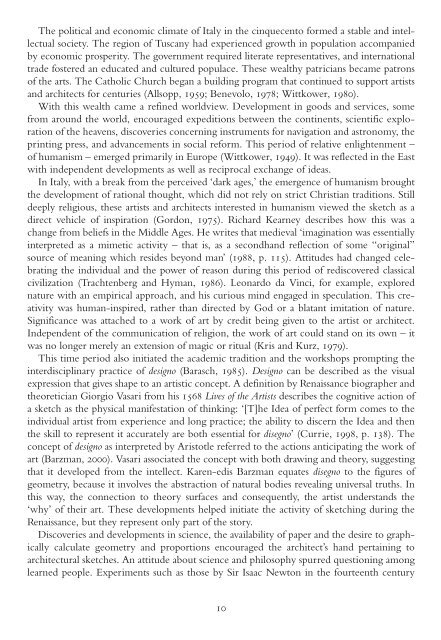Architect Drawings : A Selection of Sketches by World Famous Architects Through History
Create successful ePaper yourself
Turn your PDF publications into a flip-book with our unique Google optimized e-Paper software.
The political and economic climate <strong>of</strong> Italy in the cinquecento formed a stable and intellectual<br />
society. The region <strong>of</strong> Tuscany had experienced growth in population accompanied<br />
<strong>by</strong> economic prosperity. The government required literate representatives, and international<br />
trade fostered an educated and cultured populace. These wealthy patricians became patrons<br />
<strong>of</strong> the arts. The Catholic Church began a building program that continued to support artists<br />
and architects for centuries (Allsopp, 1959; Benevolo, 1978; Wittkower, 1980).<br />
With this wealth came a refined worldview. Development in goods and services, some<br />
from around the world, encouraged expeditions between the continents, scientific exploration<br />
<strong>of</strong> the heavens, discoveries concerning instruments for navigation and astronomy, the<br />
printing press, and advancements in social reform. This period <strong>of</strong> relative enlightenment –<br />
<strong>of</strong> humanism – emerged primarily in Europe (Wittkower, 1949). It was reflected in the East<br />
with independent developments as well as reciprocal exchange <strong>of</strong> ideas.<br />
In Italy, with a break from the perceived ‘dark ages,’ the emergence <strong>of</strong> humanism brought<br />
the development <strong>of</strong> rational thought, which did not rely on strict Christian traditions. Still<br />
deeply religious, these artists and architects interested in humanism viewed the sketch as a<br />
direct vehicle <strong>of</strong> inspiration (Gordon, 1975). Richard Kearney describes how this was a<br />
change from beliefs in the Middle Ages. He writes that medieval ‘imagination was essentially<br />
interpreted as a mimetic activity – that is, as a secondhand reflection <strong>of</strong> some “original”<br />
source <strong>of</strong> meaning which resides beyond man’ (1988, p. 115). Attitudes had changed celebrating<br />
the individual and the power <strong>of</strong> reason during this period <strong>of</strong> rediscovered classical<br />
civilization (Trachtenberg and Hyman, 1986). Leonardo da Vinci, for example, explored<br />
nature with an empirical approach, and his curious mind engaged in speculation. This creativity<br />
was human-inspired, rather than directed <strong>by</strong> God or a blatant imitation <strong>of</strong> nature.<br />
Significance was attached to a work <strong>of</strong> art <strong>by</strong> credit being given to the artist or architect.<br />
Independent <strong>of</strong> the communication <strong>of</strong> religion, the work <strong>of</strong> art could stand on its own – it<br />
was no longer merely an extension <strong>of</strong> magic or ritual (Kris and Kurz, 1979).<br />
This time period also initiated the academic tradition and the workshops prompting the<br />
interdisciplinary practice <strong>of</strong> designo (Barasch, 1985). Designo can be described as the visual<br />
expression that gives shape to an artistic concept. A definition <strong>by</strong> Renaissance biographer and<br />
theoretician Giorgio Vasari from his 1568 Lives <strong>of</strong> the Artists describes the cognitive action <strong>of</strong><br />
a sketch as the physical manifestation <strong>of</strong> thinking: ‘[T]he Idea <strong>of</strong> perfect form comes to the<br />
individual artist from experience and long practice; the ability to discern the Idea and then<br />
the skill to represent it accurately are both essential for disegno’ (Currie, 1998, p. 138). The<br />
concept <strong>of</strong> designo as interpreted <strong>by</strong> Aristotle referred to the actions anticipating the work <strong>of</strong><br />
art (Barzman, 2000). Vasari associated the concept with both drawing and theory, suggesting<br />
that it developed from the intellect. Karen-edis Barzman equates disegno to the figures <strong>of</strong><br />
geometry, because it involves the abstraction <strong>of</strong> natural bodies revealing universal truths. In<br />
this way, the connection to theory surfaces and consequently, the artist understands the<br />
‘why’ <strong>of</strong> their art. These developments helped initiate the activity <strong>of</strong> sketching during the<br />
Renaissance, but they represent only part <strong>of</strong> the story.<br />
Discoveries and developments in science, the availability <strong>of</strong> paper and the desire to graphically<br />
calculate geometry and proportions encouraged the architect’s hand pertaining to<br />
architectural sketches. An attitude about science and philosophy spurred questioning among<br />
learned people. Experiments such as those <strong>by</strong> Sir Isaac Newton in the fourteenth century<br />
10




